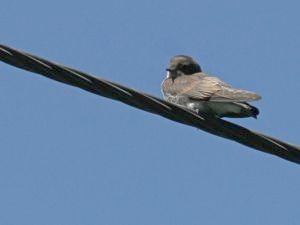 Last Saturday I walked along the Monongahela River on the South Side trail. Near the Liberty Bridge I heard the familiar spitting sound of northern rough-winged swallows. “Brrrt brrrt brrrt”.
Last Saturday I walked along the Monongahela River on the South Side trail. Near the Liberty Bridge I heard the familiar spitting sound of northern rough-winged swallows. “Brrrt brrrt brrrt”.
I looked up in the deep blue sky and finally found them, zipping by so fast that they were hard to see. Fortunately, Chuck Tague photographed one so I can show you what they look like: uniformly brown on top and on their throat, with a white belly and a square tail.
Why are they called “rough-winged?” Because their outer primary feather (the long flight feather) feels rough when you stroke it. The males have recurved barbs on this leading feather that are rougher than those found on the females. No one knows why they have this feature.
Swallows hunt insects in the air and swallow them as they fly. Just like the goldfinch, their diet governs when they nest. In the swallows’ case they lay eggs in May and the young fledge by mid-July so they can start life when insects are most plentiful.
Northern rough-winged swallows nest in burrows excavated by other species. This includes burrows humans have made such as drain holes in the sides of retaining walls and small pipes under bridges. Perhaps the swallows I saw had nested at the Liberty Bridge or in the holes in the walls along the river.
I’m glad to see swallows. I am not fond of bugs!
(photo by Chuck Tague)
The scientific name for Northern Rough-winged Swallow is Stelgidopteryx serripennis. The first word derives from the Greek “stelgido” meaning scraper, and “ptery”, meaning wing. The second word derives from the Latin “serri”, meaning saw, and “penni”, meaning feather. The coiner of both the scientific and common names of the species was obviously impressed by the serrated primary feather on the wing, and yet we still don’t know it’s function! Audubon is given priority for the scientific name, although he used a different genus name than we do now.